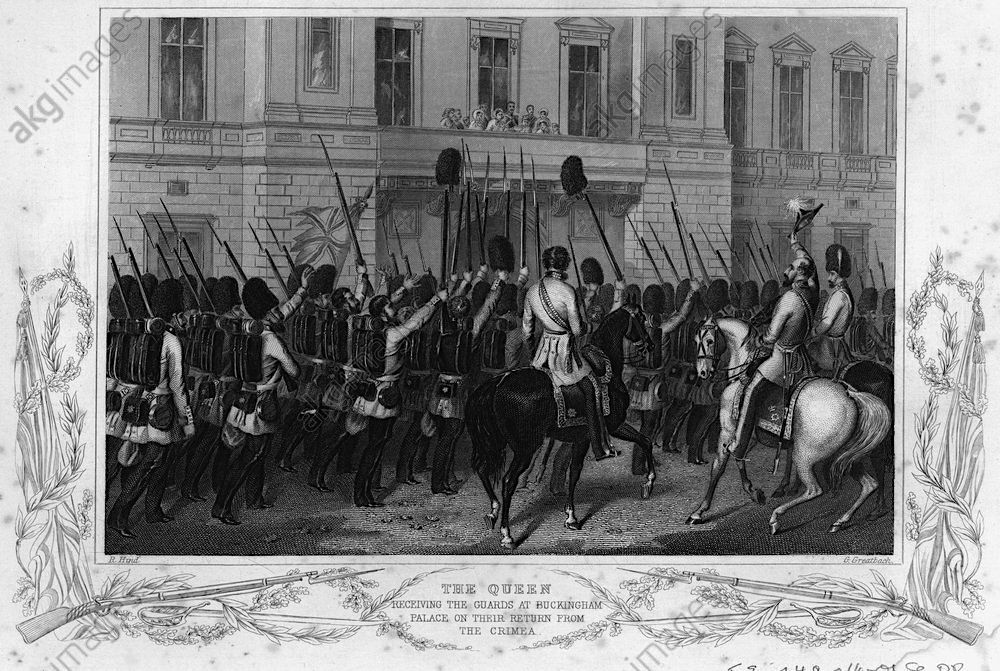Name/Title
The Queen Receiving the Guards at Buckingham Palace on their Return from The CrimeaEntry/Object ID
2001.01.01Description
Print
Steel engraving by George Greatbach after design by Robert Neal Hind.
From Williams, Lt. Colonel William Freke. 1857. "England's Battles by Sea and Land, Volume VI, Russia and Turkey". London: The London Printing and Publishing Company Limited.
This image depicts Queen Victoria and Prince Albert of Saxe-Coburg and Gotha as her consort, with other family members, on a balcony at Buckingham Palace, London, England. They are welcoming back the royal household regiment, the Coldstream Guards, after the Crimean (Russo-Turkish) War, 1853-1856. The regiment had served with distinction at the Battles of Alma, Inkerman and Sevastopol. Well-recognized over time for its high-profile ceremonial duties, the regiment had also earned a reputation as an elite fighting force.Artwork Details
Medium
Engraving on paperSubject Place
Region
Western EuropeContinent
EuropeContext
While the alliance of France, the Ottoman Empire, the United Kingdom and Piedmont-Sardinia had won the Crimean War over Russia, the gains made were negligible and relations amongst the powers in eastern Europe were not settled. For the British, the war was deemed a disaster, becoming an iconic symbol of unclear objectives, logistical and tactical failures and overall command mismanagement. Conditions were brutal and the loss of life enormous due mainly to disease. Of note, it was the first war to use new inventions and technologies such as the electric telegraph, explosive shells and "live reporting". It was also the first European war to be photographed. Public opinion in Britain was united in outrage and the Tory government was ultimately forced to resign.
It was generally held that Florence Nightingale OM, RRC (1820-1910) was the only real hero of the war. She came to prominence when she served as manager and educator leading the pioneering efforts of her team of nurses in Constantinople (now Istanbul, Turkey) to establish new life-saving patient care and sanitation measures. She was also active as a social reformer, writer, and statistician setting up the first training school for nurses in the U.K., and she ultimately changed the face of nursing from a mostly untrained job to a highly skilled and well-respected medical profession. A Jamaican-born British nurse, Mary Seacole OM (Jamaica posthumous) (1805-1881), was also recognized for her care of sick and wounded military personnel. Post-war, the Royal family instituted an energetic propaganda campaign including the establishment of the Victoria Cross for valour introduced in early 1856 by Queen Victoria, as well as the production of mass circulation commemorative prints.
____________________
This engraving is from Lt. Colonel William Freke Williams', England's Battles by Sea and Land: Russia and Turkey (London: The London Printing and Publishing Company, 1854-1859). It is a six volume set of over 50 steel-engraved plates of battles, maps, etc. Williams authored and co-authored other military history publications such as "England's Battles By Sea And Land: History Of England's Campaigns In India And China" and "The Life and Times of the Late Duke of Wellington".Made/Created
Artist Information
Artist
Robert Neal Hind (1817-1879)Role
ArtistArtist
George Greatbach (1819-1884)Role
EngraverArtist
The London Printing and Publishing Co. Ltd.Role
PublisherArtist
Lt. Colonel William Freke Williams (1793-1860)Role
AuthorDate made
1857Time Period
19th CenturyNotes
ARTIST, etc. BIOGRAPHIES
- Robert Neal Hind was a British draughtsman and watercolour painter of military, sporting and sentimental subjects.
- George Greatbach was a British engraver, brother of engraver and illustrator William Greatbach (1802-1885) and son of Daniel Greatbach (1780-1864). Sometimes spelled Greatbatch.
- The London Printing and Publishing Co. Ltd. operated in London ca. 1800-1850 and then in New York ca. 1850-1882.
- Lt. Colonel (later Maj. General) William Freke Williams was born in Manchester, served in the British army (The 85th, or The King’s Regiment of Light Infantry - Bucks Volunteers, later merged into The King’s Light Infantry - Shropshire Regiment), and was the author of publications related to military history.Inscription/Signature/Marks
Type
Inscription, LabelLocation
In print with elaborate decorative border -
Lower centre: The Queen Receiving the Guards at Buckingham Palace on Their Return From The Crimea
Lower left: R. Hind
Lower right: G. Greatbach
Bottom centre margin (not visible): The London Printing and Publishing Company Limited
Verso frame, paper label:
Donated to the Union Club by Capt. David Price H Aide C.C.D. 2 June '93.Dimensions
Dimension Description
SupportHeight
15.2 cmWidth
22.2 cmAcquisition
Acquisition Method
GiftDate
1993Notes
Legacy collection
Plaque: Presented to Capt. D. Price CDH. Aide DeC. from Victoria Militia District HQ. 1984-1988. Donated by Capt. David Price CDH, Aide DeC, 1993

![The Royal Family on the terrace at Osborne [House, Isle of Wight, U.K.], 26 May 1857.: Albumen print by Caldesi & Montecchi. Royal Collection Trust, U.K.
From left to right (Queen Victoria and Prince Albert with their nine children): Prince Alfred, Princess Alice, Princess Helena, Prince Leopold, Prince Albert, the Queen holding Princess Beatrice, Prince Arthur, Princess Royal, Prince of Wales and Princess Louise.](https://d3f1jyudfg58oi.cloudfront.net/5457/image/3cfbc5e0-d7e1-11ed-9f59-8138be004713-uB4NaK7.tn@2x.jpg)

